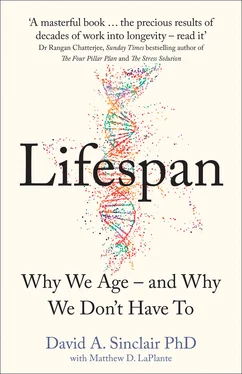In simple species, like ancient M. superstes and fungi today, epigenetic information storage and transfer is important for survival. For complex life, it is essential. By complex life, I mean anything made up of more than a couple of cells: slime molds, jellyfish, worms, fruit flies, and of course mammals like us. Epigenetic information is what orchestrates the assembly of a human newborn made up of 26 billion cells from a single fertilized egg and what allows the genetically identical cells in our bodies to assume thousands of different modalities. 24
If the genome were a computer, the epigenome would be the software. It instructs the newly divided cells on what type of cells they should be and what they should remain, sometimes for decades, as in the case of individual brain neurons and certain immune cells.
That’s why a neuron doesn’t one day behave like a skin cell and a dividing kidney cell doesn’t give rise to two liver cells. Without epigenetic information, cells would quickly lose their identity and new cells would lose their identity, too. If they did, tissues and organs would eventually become less and less functional until they failed.
In the warm ponds of the primordial Earth, a digital chemical system was the best way to store long-term genetic data. But information storage was also needed to record and respond to environmental conditions, and this was best stored in analog format. Analog data are superior for this job because they can be changed back and forth with relative ease whenever the environment within or outside the cell demands it, and they can store an almost unlimited number of possible values, even in response to conditions that have never been encountered before. 25
The unlimited number of possible values is why many audiophiles still prefer the rich sounds of analog storage systems. But even though analog devices have their advantages, they have a major disadvantage. In fact, it’s the reason we’ve moved from analog to digital. Unlike digital, analog information degrades over time—falling victim to the conspiring forces of magnetic fields, gravity, cosmic rays, and oxygen. Worse still, information is lost as it’s copied.
No one was more acutely disturbed by the problem of information loss than Claude Shannon, an electrical engineer from the Massachusetts Institute of Technology (MIT) in Boston. Having lived through World War II, Shannon knew firsthand how the introduction of “noise” into analog radio transmissions could cost lives. After the war, he wrote a short but profound scientific paper called “The Mathematical Theory of Communication” on how to preserve information, which many consider the foundation of Information Theory. If there is one paper that propelled us into the digital, wireless world in which we now live, that would be it. 26
Shannon’s primary intention, of course, was to improve the robustness of electronic and radio communications between two points. His work may ultimately prove to be even more important than that, for what he discovered about preserving and restoring information, I believe, can be applied to aging.
Don’t be disheartened by my claim that we are the biological equivalent of an old DVD player. This is actually good news. If Szilard had turned out to be right about mutations causing aging, we would not be able to easily address it, because when information is lost without a backup, it is lost for good. Ask anyone who’s tried to play or restore content from a DVD that’s had an edge broken off: what is gone is gone.
But we can usually recover information from a scratched DVD. And if I am right, the same kind of process is what it will take to reverse aging.
As cloning beautifully proves, our cells retain their youthful digital information even when we are old. To become young again, we just need to find some polish to remove the scratches.
This, I believe, is possible.
A TIME TO EVERY PURPOSE
The Information Theory of Aging starts with the primordial survival circuit we inherited from our distant ancestors.
Over time, as you might expect, the circuit has evolved. Mammals, for instance, don’t have just a couple of genes that create a survival circuit, such as those that first appeared in M. superstes . Scientists have found more than two dozen of them within our genome. Most of my colleagues call these “longevity genes” because they have demonstrated the ability to extend both average and maximum lifespans in many organisms. But these genes don’t just make life longer, they make it healthier, which is why they can also be thought of as “vitality genes.”
Together, these genes form a surveillance network within our bodies, communicating with one another between cells and between organs by releasing proteins and chemicals into the bloodstream, monitoring and responding to what we eat, how much we exercise, and what time of day it is. They tell us to hunker down when the going gets tough, and they tell us to grow fast and reproduce fast when the going gets easier.
And now that we know these genes are there and what many of them do, scientific discovery has given us an opportunity to explore and exploit them; to imagine their potential; to push them to work for us in different ways. Using molecules both natural and novel, using technology both simple and complex, using wisdom both new and old, we can read them, turn them up and down, and even change them altogether.
The longevity genes I work on are called “sirtuins,” named after the yeast SIR2 gene, the first one to be discovered. There are seven sirtuins in mammals, SIRT1 to SIRT7 , and they are made by almost every cell in the body. When I started my research, sirtuins were barely on the scientific radar. Now this family of genes is at the forefront of medical research and drug development.
Descended from gene B in M. superstes , sirtuins are enzymes that remove acetyl tags from histones and other proteins and, by doing so, change the packaging of the DNA, turning genes off and on when needed. These critical epigenetic regulators sit at the very top of cellular control systems, controlling our reproduction and our DNA repair. After a few billion years of advancement since the days of yeast, they have evolved to control our health, our fitness, and our very survival. They have also evolved to require a molecule called nicotinamide adenine dinucleotide, or NAD. As we will see later, the loss of NAD as we age, and the resulting decline in sirtuin activity, is thought to be a primary reason our bodies develop diseases when we are old but not when we are young.
Trading reproduction for repair, the sirtuins order our bodies to “buckle down” in times of stress and protect us against the major diseases of aging: diabetes and heart disease, Alzheimer’s disease and osteoporosis, even cancer. They mute the chronic, overactive inflammation that drives diseases such as atherosclerosis, metabolic disorders, ulcerative colitis, arthritis, and asthma. They prevent cell death and boost mitochondria, the power packs of the cell. They go to battle with muscle wasting, osteoporosis, and macular degeneration. In studies on mice, activating the sirtuins can improve DNA repair, boost memory, increase exercise endurance, and help the mice stay thin, regardless of what they eat. These are not wild guesses as to their power; scientists have established all of this in peer-reviewed studies published in journals such as Nature , Cell , and Science .
And in no small measure, because sirtuins do all of this based on a rather simple program—the wondrous gene B in the survival circuit—they’re turning out to be more amenable to manipulation than many other longevity genes. They are, it would appear, one of the first dominos in the magnificent Rube Goldberg machine of life, the key to understanding how our genetic material protects itself during times of adversity, allowing life to persist and thrive for billions of years.
Читать дальше












